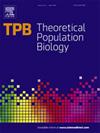土壤传播蠕虫抗虫性的生态进化动态
IF 1.3
4区 生物学
Q4 ECOLOGY
引用次数: 0
摘要
土壤传播的蠕虫寄生虫对最广泛使用的药物的抗虫性(AR)是人类感染和牲畜感染物种持续关注的问题。有大量证据表明家畜中存在过敏性鼻炎,但人类较少,这可能是由于各种原因造成的。在本文中,我们开发了一个生态进化模型,将这些寄生虫的生命周期与它们在单个双等位基因遗传位点的潜在进化结合起来,从而赋予对治疗药物的抗性。我们确定了有效消除种群所需的临界治疗频率,对于固定的药物疗效(没有进化),并使用它来分类生态进化模型的三种定性不同行为。然后,我们描述了生命周期的各个方面如何影响定性结果的实现和抗性等位基因的传播速度,比较了人类感染和牲畜感染物种的参数化模型。除了一个物种外,我们发现较低的繁殖率和较低的接触率加速了抗药性的传播,而较低的幼虫死亡率则减缓了抗药性的传播。十二指肠钩虫和环切石尾虫的生命周期参数分别与耐药性传播最快和最慢有关。我们讨论了产生这些结果的机理原因。本文章由计算机程序翻译,如有差异,请以英文原文为准。
Eco-evolutionary dynamics of anthelmintic resistance in soil-transmitted helminths
Anthelmintic resistance (AR) of soil-transmitted helminth parasites against the most widely available drugs is an ongoing concern for both human-infecting and livestock-infecting species. There has been substantial evidence of AR in livestock but less in humans, which may be due to a variety of reasons. In this paper, we develop an eco-evolutionary model that couples the life cycle of these parasites with their underlying evolution in a single biallelic genetic locus that confers resistance to treatment drugs. We determine the critical treatment frequency needed to effectively eliminate the population, for a fixed drug efficacy (without evolution) and use this to classify three qualitative distinct behaviors of the eco-evolutionary model. Then, we describe how aspects of the life cycle influence which qualitative outcome is achieved and the rate of spread of the resistance allele, comparing across parameterized models of human-infecting and livestock-infecting species. For all but one species, we find that lower fecundity rates and lower contact rates speed the spread of resistance, while lower larval death slows it down. The life cycle parameters of Ancylostoma duodenale and Ostertagia circumcincta are associated with the fastest and slowest spread of resistance, respectively. We discuss the mechanistic reason for these results.
求助全文
通过发布文献求助,成功后即可免费获取论文全文。
去求助
来源期刊

Theoretical Population Biology
生物-进化生物学
CiteScore
2.50
自引率
14.30%
发文量
43
审稿时长
6-12 weeks
期刊介绍:
An interdisciplinary journal, Theoretical Population Biology presents articles on theoretical aspects of the biology of populations, particularly in the areas of demography, ecology, epidemiology, evolution, and genetics. Emphasis is on the development of mathematical theory and models that enhance the understanding of biological phenomena.
Articles highlight the motivation and significance of the work for advancing progress in biology, relying on a substantial mathematical effort to obtain biological insight. The journal also presents empirical results and computational and statistical methods directly impinging on theoretical problems in population biology.
 求助内容:
求助内容: 应助结果提醒方式:
应助结果提醒方式:


